Introduction
The Two groundbreaking fields in the world of technology, Artificial Intelligence (AI) and Virtual Reality (VR), are converging to create a synergistic future that holds immense promise and potential. This dynamic intersection is reshaping the way we perceive and interact with the digital world, opening up new avenues for innovation, creativity, and immersive experiences.
Understanding Artificial Intelligence
At the heart of this synergy lies Artificial Intelligence, a field that involves the development of intelligent machines capable of performing tasks that traditionally required human intelligence. AI encompasses a spectrum of technologies, including machine learning, natural language processing, and computer vision, all aimed at enabling machines to simulate human-like intelligence.
Machine Learning’s Role
Machine learning, a subset of AI, plays a pivotal role in enhancing the capabilities of virtual reality. By analyzing vast amounts of data, machine learning algorithms can adapt and improve, creating more realistic and responsive virtual environments. This adaptability ensures that VR experiences become increasingly personalized and tailored to individual preferences.
Natural Language Processing Enhancing Interaction
Natural Language Processing (NLP) within AI is transforming the way we interact with virtual environments. Through voice commands and natural language understanding, users can communicate with AI-driven elements in VR, creating a more intuitive and immersive experience. This seamless interaction fosters a sense of presence, blurring the lines between the physical and virtual realms.
Computer Vision for Realistic Environments
In the realm of Virtual Reality, Computer Vision is a game-changer. This technology enables VR systems to interpret and respond to the real-world environment, enhancing the user’s sense of presence and immersion. By incorporating computer vision, VR experiences can simulate realistic interactions and reactions to the user’s movements and gestures.
The Rise of Virtual Reality
Virtual Reality, on the other hand, is a technology that immerses users in a simulated environment, often generated by a computer. VR has come a long way from its inception, evolving from niche applications to widespread use in various industries, including gaming, healthcare, education, and business.
Enhanced Realism in VR Environments
The synergy between AI and VR is transforming virtual environments into hyper-realistic spaces. AI algorithms contribute to the creation of detailed and responsive virtual worlds, where every interaction feels natural and dynamic. This heightened realism not only enhances entertainment experiences but also finds applications in training simulations, medical procedures, and architectural design.
Personalized Experiences through AI in VR
One of the most significant advantages of integrating AI into VR is the ability to deliver personalized experiences. Machine learning algorithms analyze user behavior and preferences, adapting VR environments to individual needs. Whether it’s tailoring gaming experiences, educational content, or virtual tours, AI ensures that VR becomes a personalized and engaging space for each user.
The Future of Entertainment
The entertainment industry is at the forefront of embracing the synergies between AI and VR. From AI-driven characters in virtual games that adapt to the player’s strategies to immersive storytelling experiences that respond to the viewer’s choices, the future of entertainment is set to be more interactive and engaging than ever before.
Revolutionizing Education and Training
In the realm of education and training, the combination of AI and VR is revolutionizing traditional approaches. Virtual classrooms powered by AI can adapt to individual learning styles, providing personalized lessons and feedback. Training simulations in various industries benefit from realistic scenarios generated by AI algorithms, preparing professionals for real-world challenges.
Healthcare Applications
The healthcare sector is another domain where the intersection of AI and VR is making significant strides. Surgical training simulations, patient rehabilitation programs, and mental health therapies are leveraging the immersive capabilities of VR enhanced by AI. This not only improves the effectiveness of medical training but also enhances patient care and rehabilitation outcomes.
Challenges and Ethical Considerations
As we delve deeper into the synergistic future of AI and VR, it is crucial to acknowledge and address challenges and ethical considerations. Issues related to privacy, data security, and the potential misuse of AI-driven VR experiences need careful consideration. Striking a balance between innovation and responsible development is imperative to ensure the positive impact of these technologies.
Conclusion
The intersection of Artificial Intelligence and Virtual Reality marks a transformative era in the tech landscape. As these two fields synergize, the possibilities for innovation, personalization, and immersion are boundless. From entertainment and education to healthcare and beyond, the collaborative power of AI and VR is reshaping the way we experience and interact with the digital world. The future holds exciting prospects as we continue to unlock the full potential of this synergistic convergence.



































